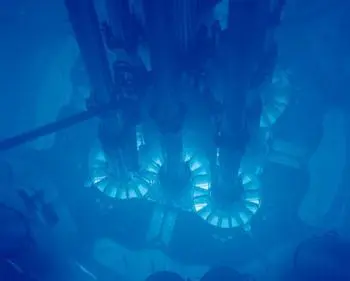
A coolant in a nuclear reactor is a liquid or gaseous substance that passes through the fuel rods in the reactor core and removes the heat from the nuclear fission reaction during the reactor operation.
Power generation plants that use nuclear energy to obtain electrical energy generate a large amount of thermal energy. The heat generated must be dissipated because otherwise, the reactor’s temperature would rise so much that it could melt.
In dual-circuit power reactors, the reactor coolant enters the steam generator that produces steam that drives the turbines. On the other hand, in single-circuit reactors, the refrigerant (steam or gas) can serve as the working fluid of the turbine cycle.
In research (for example, materials science) and special reactors (for instance, in reactors for the accumulation of radioactive isotopes), the coolant only cools the reactor. The resulting heat is not used.
The coolant in a nuclear power plant and the control rods are two of the most critical safety systems in a nuclear power plant.
What are the nuclear refrigerant requirements?
The coolant used in these electrical generators must meet the following requirements:
-
Weak absorption of neutrons (in thermal reactors) or weakening of them (in fast reactors). The objective is to reduce the thermal energy but not to reduce the power of the reactor.
-
Chemical resistance under conditions of intense radiation exposure.
-
Low corrosivity for the structural materials with which the coolant is in contact.
-
High heat transfer coefficient for heat to flow rapidly from the reactor to the coolant atoms.
-
High specific heat.
-
Low working pressure at high temperatures.
Types of nuclear refrigerants
The nuclear coolants used in a reactor vary depending on the type of nuclear reactor:
-
Thermal neutron reactors use water (regular and heavy), water vapor, organic liquids, carbon dioxide as a coolant.
-
Fast nuclear reactors use liquid metals (mainly sodium) and gases (for instance, water vapor and helium). Often the liquid serves as a coolant, which is also a neutron moderator.
Light water
One of the most common heat carriers is water. Natural water contains a small amount of heavy water (0.017%), various impurities, and dissolved gases. The presence of pollutants and gases makes water chemically active with metals. Therefore, before using it as a heat carrier, the water is purified of impurities by distillation, and gases are removed from the water.
Radioactive water circulates in the primary circuit of the nuclear plant. The main source of radioactivity in water is impurities, whose appearance is due to corrosion of the primary circuit nodes and technological contamination by fissile substances on the external surface of fuel elements. The concentration of radioactive impurities in the water is reduced by filtration.
Advantages and disadvantages of using light water as a nuclear coolant
The disadvantages of using water as a coolant are the low boiling point (100 ° C at a pressure of 1 atm) and the absorption of thermal neutrons. The first drawback is eliminated by increasing the pressure in the primary circuit. The absorption of thermal neutrons by water is compensated by using nuclear fuel based on enriched uranium.
Heavy water
Heavy water, in its chemical and thermal properties, is a little different from ordinary water. It practically does not absorb neutrons, making it possible to use natural uranium as a nuclear fuel in nuclear reactors with a heavy water moderator.
However, heavy water is still little used in reactor construction due to its high cost.
Examples of a reactor using this coolant in a nuclear reactor are light water reactors such as boiling water reactors (BWR) or pressurized water reactors (PWR). They are the most used reactors in the United States.
Liquid metals
Fast reactors have a high power density and do not need neutron moderation to slow down the neutrons. The most developed are metallic coolants made of sodium.
This refrigerant is chemically active with most metals at a relatively low temperature, and this sodium activity is due to the mixing of sodium oxides. Thus, sodium is wholly cleaned of oxides, after which it does not react with many metals (Mo, Zr, stainless steel, etc.) at 600–900 ° C.
Organic liquids
Of the organic liquids tested, some of the polyphenyls, including diphenyl and triphenyl, were the most stable under elevated temperatures and radiation exposure conditions.
However, despite the advantages, these refrigerants turned out to be too unstable for neutron irradiation, so these reactors were not used industrially.
Gas
The primary refrigerant in gas is carbon dioxide. It is economical, characterized by a higher density and volumetric heat capacity compared to other gases. However, the corrosive effect of carbon dioxide on metals depends on the oxygen content.
The gas-cooled reactor (GCR) is the type of reactor that uses this nuclear coolant.